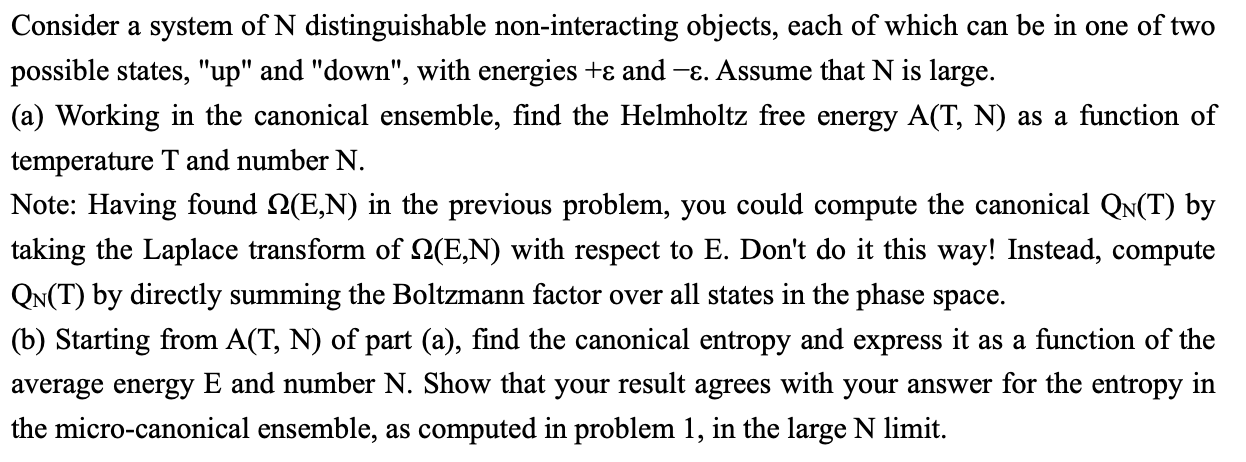Consider a system of N distinguishable non-interacting objects, each of which can be in one of two possible states, "up" and "down", with energies +ɛ and -e. Assume that N is large. (a) Working in the canonical ensemble, find the Helmholtz free energy A(T, N) as a function of temperature T and number N. Note: Having found 2(E,N) in the previous problem, you could compute the canonical QN(T) by taking the Laplace transform of N(E,N) with respect to E. Don't do it this way! Instead, compute QN(T) by directly summing the Boltzmann factor over all states in the phase space. (b) Starting from A(T, N) of part (a), find the canonical entropy and express it as a function of the average energy E and number N. Show that your result agrees with your answer for the entropy in the micro-canonical ensemble, as computed in problem 1, in the large N limit.
Consider a system of N distinguishable non-interacting objects, each of which can be in one of two possible states, "up" and "down", with energies +ɛ and -e. Assume that N is large. (a) Working in the canonical ensemble, find the Helmholtz free energy A(T, N) as a function of temperature T and number N. Note: Having found 2(E,N) in the previous problem, you could compute the canonical QN(T) by taking the Laplace transform of N(E,N) with respect to E. Don't do it this way! Instead, compute QN(T) by directly summing the Boltzmann factor over all states in the phase space. (b) Starting from A(T, N) of part (a), find the canonical entropy and express it as a function of the average energy E and number N. Show that your result agrees with your answer for the entropy in the micro-canonical ensemble, as computed in problem 1, in the large N limit.
Related questions
Question
It's a statistical mechanics question.

Transcribed Image Text:Consider a system of N distinguishable non-interacting objects, each of which can be in one of two
possible states, "up" and "down", with energies +ɛ and -e. Assume that N is large.
(a) Working in the canonical ensemble, find the Helmholtz free energy A(T, N) as a function of
temperature T and number N.
Note: Having found 2(E,N) in the previous problem, you could compute the canonical QN(T) by
taking the Laplace transform of N(E,N) with respect to E. Don't do it this way! Instead, compute
QN(T) by directly summing the Boltzmann factor over all states in the phase space.
(b) Starting from A(T, N) of part (a), find the canonical entropy and express it as a function of the
average energy E and number N. Show that your result agrees with your answer for the entropy in
the micro-canonical ensemble, as computed in problem 1, in the large N limit.
Expert Solution
This question has been solved!
Explore an expertly crafted, step-by-step solution for a thorough understanding of key concepts.
This is a popular solution!
Trending now
This is a popular solution!
Step by step
Solved in 3 steps
